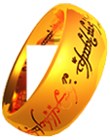Places in Middle-earth
Angle, The
Type: Forests, Fields, Plains
Region: Arnor/Eriador/Lindon
Location: The triangular region of Eriador between the Mitheithel and Bruinen rivers on the northwest and southwest, and the Misty Mountains on the east; only accessible from the west via the Last Bridge.
Description:
Rhudaur was in the North-east [of the former kingdom of Arnor] and lay between the Ettenmoors, the Weather Hills, and the Misty Mountains, but included also the Angle between the Hoarwell and the Loudwater.
The Lord of the Rings, Appendix A, Annals of the Kings and Rulers: Eriador, Arnor, and the Heirs of Isildur: The North-kingdom and the Dúnedain
'I am afraid we must go back to the Road here for a while,' said Strider. 'We have now come to the River Hoarwell, that the Elves call Mitheithel. It flows down out of the Ettenmoors, the troll-fells north of Rivendell, and joins the Loudwater away in the South. Some call it the Greyflood after that. It is a great water before it finds the Sea. There is no way over it below its sources in the Ettenmoors, except by the Last Bridge on which the Road crosses.'
'What is that other river we can see far away there?' asked Merry.
'That is Loudwater, the Bruinen of Rivendell,' answered Strider. 'The Road runs along the edge of the hills for many miles from the Bridge to the Ford of Bruinen.'
The Fellowship of the Ring, LoTR Book 1, Ch 12, Flight to the Ford
Michael Martinez, a Middle-earth scholar, suggests that the Angle was most likely to be the "hidden fastness" wherein the bulk of the Dúnedain of the North dwelt:
[Before] the War of the Ring, there was a man named [Dírhael 1], and his wife was [Ivorwen 1]..., and they dwelt in a hidden fastness in the wilds of Eriador; for they were of the ancient people of the Dúnedain, that of old were kings of men, but were now fallen on darkened days.
The Peoples of Middle-Earth, HoME Vol 12, Part 1, Ch 9, The Making of Appendix A: The Tale of Aragorn and Arwen
[A] "hidden fastness" would not likely be located in Minhiriath, and the close association with Imladris seems to imply there were more Dúnedain in eastern Eriador than in the western Eriador. Add to that the fact that there were no mannish settlements outside of Bree any closer to the Shire than 300 miles, and one is hard put to suggest what men could possibly be living at that range, unless they were indeed Dúnedain dwelling in or beyond the Angle.
"Ranger For Hire: Have Horse, Will Travel", by Michael Martinez, 17 Dec. 1999.
<www.suite101.com/article.cfm/tolkien/30354/2>.
History
circa 1150
The Fallohides enter Eriador. The Stoors come over the Redhorn Pass and move to the Angle, or to Dunland.
circa 1300
Evil things begin to multiply again.... The Nazgûl reappear. The chief of these comes north to Angmar. The Periannath migrate westward; many settle at Bree.
1356
... About this time the Stoors leave the Angle, and some return to Wilderland.
The Lord of the Rings, Appendix B, The Tale of Years: The Third Age
It was at this time that the Stoors that had dwelt in the Angle (between Hoarwell and Loudwater) fled west and south, because of the wars, and the dread of Angmar, and because the land and clime of Eriador, especially in the east, worsened and became unfriendly.
The Lord of the Rings, Appendix A, Annals of the Kings and Rulers: Eriador, Arnor, and the Heirs of Isildur: The North-kingdom and the Dúnedain
Notes
1 This text is from one of Tolkien's early drafts. For the sake of clarity, earlier versions of proper names used by Tolkien in this draft have been replaced with the versions in use in the canon sources. All substitutions are marked with brackets.
Contributors:
Elena Tiriel 6Jul06, 17Apr10
